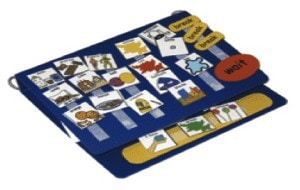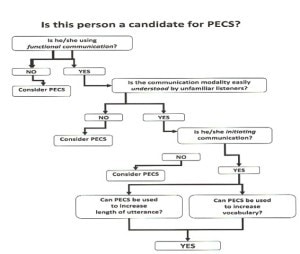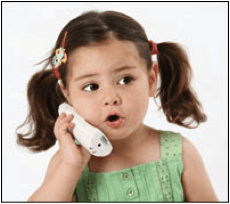I’m sure many of you might be thinking what exactly is PECS? PECS is a form of augmentative and alternation communication that is used to help individuals, who have limited or no functional communication skills, to learn in a systematic and evidenced based manner. PECS can help with the development of speech, and most likely achieve a reduction in behavior issues. Below is a flow chart to decide if your child is a good candidate for PECS (click on the flowchart for a clearer view):
Copyright, 2012 by Pyramid Educational Consutlants (www.pecs.com).
What are the Benefits of PECS?
- PECS teaches an easier way to communicate
- PECS makes it easier for children to request their wants/needs
- Can decrease challenging behaviors
- Can encourage speech
- It focuses on initiation
- It is easily understood by everyone
- Evidenced-based
How Does PECS work?
PECS is taught through 6 phases:
Phase I: Physical Exchange
The goal in this phase is to initiate communicative interaction and to teach the student HOW to communicate. Picture discrimination is not required in this phase- it is simply learning the rules of communication
Once the student shows initiation, we need to teach the motor response to:
- Pick up
- Reach
- Release
This phase is taught using a 2 person prompt procedure. The physical prompter waits for initiation then prompts the pickup, reach, and release procedure. The communicative partner puts out their empty hand to provide information as to where to put the picture and delivers the reinforcer within half a second, labels the item and praises student.
Phase II: Distance and Persistence
The goal in this phase is to teach the student to persist across obstacles. In this phase each student should have a book. The student should be taught to travel to the communicative partner with their book or to get the picture from the book, and from room to room with the book. It is important to note to never say “get your book.”
Phase III: Discrimination
The goal in this phase is to teach the student to choose from all the pictures on or in the book. Only one teacher is needed in this phase.
IIIA: Simple Discrimination
In phase 3A motivation is the key part in getting the student to choose the correct picture to get the desired item. The student will learn a new skill, which is choosing the correct picture of the desired item or activity and not choosing the picture of the non-preferred item. The pictures should be rearranged after each correct trial and kept in the same position after an incorrect trial. If the student gets an error a specific error correction procedure is applied.
IIIB: Discrimination between multiple pictures of preferred items
In phase 3B the student will demonstrate a correspondence between the picture and the chosen item. To determine whether the student’s actions match the request a “correspondence check” is performed. If the student reaches for the non-corresponding item then the communication partner will block it and perform the error correction.
Phase IV: Sentence Structure
In this phase the goal is to build towards spontaneous commenting by having the student construct and exchange the Sentence Strip. In this phase an “I want” picture is introduced. The student is taught to put the “I want” picture on the strip, add the reinfocer picture, and then to remove the strip and exchange the strip. After the exchange, the student points to each picture as they read the strip and the teacher delivers the reinforcer.
Attributes: Descriptive Vocabulary
In this phase the goal is to use attributes to request specific reinforcers using colors, shapes, sizes, action words, etc.
Phase V: Responsive Requesting
In this phase, the goal is to alternate between opportunities for spontaneous requesting and answering, “what do you want?”
Phase VI: Commenting
In this phase, the long-term goal is for the student to spontaneously comment about the world around him. This phase is difficult for many students who do not respond to social reinforcement. In order to make it more reinforcing first have the student answer questions that are motivating to him, such as:
- What do you see?
- What is it?
- What do you smell?
Please see Pyramid Educational Consultants, Inc. at pecsproducts.com for the PECS Training Manual and other resources to make implementation more efficient. For more information about PECS and PECS training go to pecsusa.com or contact Pyramid at pyramidus@pecs.com or 888-732-7462 (toll free).
Adapted from:
Frost, L.A., & Bondy, A. S. (2002). The Picture exchange communication system training manual (2nd ed.). Newark, DE: Pyramid Educational Consultants



